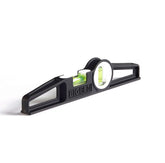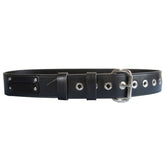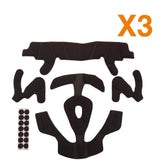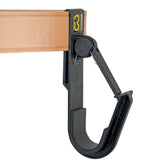We've all been there, kicked back in our comfies, ready to relax for the evening, when you hear those dreaded words: “Can you take this out to the recycling bin?” For pure speed and convenience, we grab the first footwear we can find. Your wife’s slippers? Your dad’s sandals? Doesn’t matter, as long as you can get it done and back inside to the warmth. Sure, the worst outcome here is probably breaking your dad’s sandal strap while trying to run back inside.
But when it comes to scaffolding and construction, cutting corners is dangerous. Skipping the proper steps of PPE (or not wearing it at all!) on-site can put you and your colleagues at serious risk.
The Facts Speak for Themselves
Research released in [1]2020 discovered that only about 60% of construction workers use PPE during work. Lack of PPE or not wearing the right kind can be more than just a mistake, it can be life-threatening.
It was recorded that between [2]2015 and 2016, there were 144 workplace fatalities and a staggering 621,000 non-fatal injuries across all industries that related to no or mis-worn PPE.
This leaves us with the devastating reality that many of those lives that were lost could have been prevented with the right protection.

The Health & Safety Executive (HSE) figures illustrate that there are around 9,000 PPE-related incidents each year.
With evidence this clear that shows just how many lives are impacted by the lack of PPE, it begs the question, why are people still not wearing it? What’s stopping workers from using the very equipment designed to keep them safe?
Further research from HSE points to four main reasons:
- No clear procedures in place
- Lack of supervision
- Poor understanding of risks
- Human error or misjudgment
It’s clear that with stronger management, better communication, and more in-depth training, workers will be more inclined to wear PPE confidently and continuously. When workers know the risks and have the right knowledge, they’re far more likely to use PPE correctly. Employers also have the responsibility to ensure that the PPE is comfortable, doesn’t restrict movement, and allows the job to be done safely and efficiently. Cutting corners might save a few seconds, but is it worth the risk?

While we can’t stand behind you, breathing down your neck every five minutes to make sure your PPE is on correctly, we can educate and highlight the importance and dangers of PPE, helping to build a safer environment for the industry.
The Importance of PPE when Cutting & Spraying
PPE is a barrier against harmful chemicals, bacteria, or objects, helping to reduce the risk of work-related injuries, fatalities, and illnesses.
Whether you're in construction, scaffolding, oil & gas, or working for yourself, you can almost guarantee that cutting or spraying is somewhere involved. Whether it’s cutting through metal or spraying paint, wearing the right PPE isn’t optional but essential. These materials and substances aren’t just tough, they can be dangerous if you’re not properly protected.
Research commissioned by [3]HSE found that construction workers who regularly worked with paint were at significantly higher risk of serious health issues.
A deeper investigation revealed that in 2005, 250 workers from this group lost their lives to lung, bladder, or stomach cancer.
However, it’s important to note that paint formulas and chemical safety have come a long way since the time these individuals would have been exposed.
Some paints contain solvent vapours and reactive chemicals that can do more than just leave you feeling lightheaded. [4]Short-term exposure can cause nausea, throat irritation, drowsiness, and even occupational asthma. But the real danger lies in long-term exposure, which can lead to serious, life-threatening conditions like liver and kidney damage, or even cancer.
It’s crucial to ensure PPE is firmly secure and fitted to avoid any chemicals from seeping through. Paint particles are present whenever the product is in use, so for every use, it’s important to be aware of the long-term dangers this could pose if PPE is not properly secured.

Whether you’re cutting tiles for a domestic job or metal poles for an industrial project, each shares the same risks and hazards.
Another survey conducted by HSE found that [5]43% of construction workers had sustained a cut or laceration injury at some point in their career.
It’s unclear how these injuries were sustained, although the top three most common causes may just give us some clues:
- Sharp tools and equipment such as saws, knives, and grinders.
- Handling sharp materials such as glass, metal, and, wood.
- Machinery such as drills and cutters.
Safety When Cutting
When cutting, it’s not unusual for parts of the material to break off under the pressure, falling to the floor or worse, flying towards the user. Protecting your eyes is extremely detrimental when taking part in such tasks, no matter how much experience you have, the possible is never impossible.
Take the Lucerne Anti-Scratch Safety Eyewear for example. Its flexible super-grip side arms are designed for security, ensuring they do not slip off and are secured comfortably to the user. In turn, this gives the user peace of mind that they can carry out even the most complex cutting tasks without the worry of them becoming loose.
To enhance comfort, a soft nose bridge and brow pad are strategically placed to provide a pleasant and cosy fit long-term. So again, no excuses! Also, the Lucerne Safety Eye Wear comes with a neck cord, ensuring they are with you when you need them and are not misplaced.
Sometimes while cutting, we can be so focused on protecting our hands and eyes from such a task, that we forget about the ‘invisible’ dangers. Sawdust. While inhaling wood dust can lead to breathing problems, lung disease, and cancers, it’s important to note that even exposure to dust through the eyes may cause irritation and some serious damage.
The P3 Cup Shaped Dust Mask is your ultimate defence against sawdust inhalation. Designed for both comfort and efficiency, this high-performance mask features an advanced exhalation valve and adjustable straps, ensuring a secure fit and optimal airflow.
The PVC Foam Full Inner Face Seal and preformed nose bridge provide a comfy, reliable seal, eliminating the need for constant readjustment, which allows you to focus on the task at hand with confidence.
Know Your Specific Filters
What most don’t know, is that there are specific filters workers need to use when working with dust and paint vapours.
Dust requires P3 filtration, whereas dust and vapour (vapour is from solvent-based paint spraying) require PsA2 filtration (P3 for dust and A2 for vapour). This piece of information is of huge importance when considering the right mask for your line of work and must be considered for superior effectiveness.
Fostering a Safer Industry
We can only hope, with statistics that back up the importance of PPE, alongside the knowledge of the features and benefits to look out for, employees and employers will begin to start prioritising training and PPE in their day-to-day routines.
By enhancing your safety, you’re not only protecting yourself but also setting an example for those around you. Together, we can foster a culture of safety and create a more secure industry for everyone.
After all, it’s only because we care…
[2] Why do workers choose not to wear PPE?
[3] Cancer and construction: Painters - HSE
[4] Why is Paint Spraying PPE and Safety Equipment Important in the Spray – Ultrimax
[5] Focus on Safety – Reducing the risk of cuts and lacerations – Sheriff Construction





















